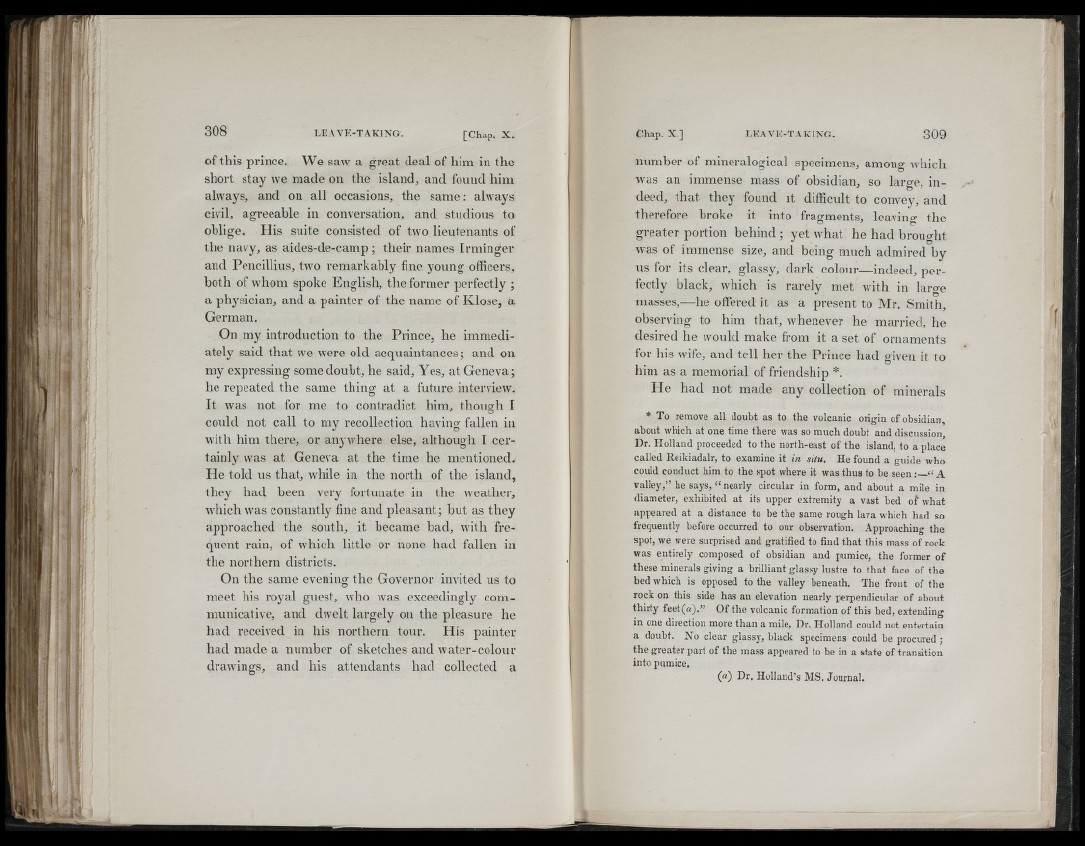
of this prince. We saw a great deal of him in the
short stay ive made on the island, and found him
always, and on all occasions, the same; always
civil, agreeable in conversation, and studious to
oblige. His suite consisted of two lieutenants of
the navy, as aides-de-camp; their names Irminger
and Pencillius, two remarkably fine young officers,
both of whom spoke English, the former perfectly ;
a physician, and a painter of the name of Klose, a
German.
On my introduction to the Prince, he immediately
said that we were old acquaintances; and on
my expressing some doubt, he said. Yes, at Geneva;
he repeated the same thing at a future interview.
It was not for me to contradict him, though I
could not call to my recollection having fallen in
with him there, or anywhere else, although I certainly
was at Geneva at the time he mentioned.
He told us that, while in the north of the island,
they had been very fortunate in the weather,
Avhich was constantly fine and pleasant; but as they
approached the south, it became bad, with frequent
rain, of which little or none had fallen in
the northern districts.
On the same evening the Governor invited us to
meet his royal guest, ivho was exceedingly communicative,
and dwelt largely on the pleasure he
had received in his northern tour. His painter
had made a number of sketches and water-colour
drawings, and his attendants had collected a
number of mineralogical specimens, among which
was an immense mass of obsidian, so large, indeed,
that they found it difficult to convey, and
therefore broke it into fragments, leaving the
greater portion behind ; yet what he had brought
was of immense size, and being much admired by
us for its clear, glassy, dark colour—indeed, perfectly
black, which is rarely met with in large
masses,—he offered it as a present to Mr. Smith,
observing to him that, whenever he married, he
desired he would make from it a set of ornaments
for his wife, and tell her the Prince had given it to
him as a memorial of friendship *.
He had not made any collection of minerals
* To remove all doubt as to the volcanic origin o f obsidian,
about which at one time there was so much doubt and discussion,
Dr. Holland proceeded to the north-east o f the island, to a place
called Reikiadalr, to examine it in situ. He found a guide who
could conduct him to the spot where it was thus to be seen A
v a lley ,” he says, “ nearly circular in form, and about a mile in
diameter, exhibited at its upper extremity a vast bed o f what
appeared at a distance to be the same rough lava which had so
frequently before occurred to our observation. Approaching the
spot, we were surprised and gratified to find that this mass of rock
was entirely composed o f obsidian and pumice, the former o f
these minerals giving a brilliant glassy lustre to that face o f the
bed which is opposed to the valley beneath. The front of the
rock on this side has an elevation nearly perpendicular o f about
thirty fe e t(rt).” Of the volcanic formation o f this bed, extending
in one direction more than a mile. Dr. Holland could not entertain
a doubt. N o clear g la ssy , black specimens could be procured ;
the greater part of the mass appeared to be in a state of transition
into pumice.
(a ) Dr, Holland’s MS. Journal.
klisli
<|V